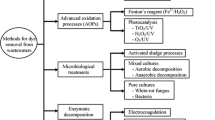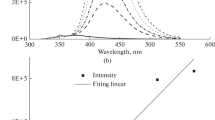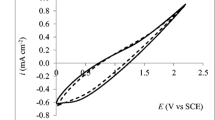Abstract
A HO· detection method based on UV–visible spectrophotometry was established to study the generation and influence mechanism of HO· during electrical advanced oxidation processes (EAOPs), and to analyze the HO· degradation mechanism of pyridine. The ability of HO· capturing agents, salicylic acid (SA) and terephthalic acid (TA) were compared. Compared with SA, TA has a larger cumulative capture of HO· and a higher capture efficiency. The effects of electrochemical conditions were investigated by using TA as a scavenger. The results show that the foam nickel electrode has higher energy efficiency. With the increase of electrolyte concentration, the rate of electron migration in solution is accelerated, which greatly improves the yield of HO·. At the same time, alkaline conditions are more conducive to the formation of HO·. The increase of current density can accelerate the generation of HO·. The degradation mechanism of pyridine in the electrochemical system under different pH conditions was studied. The GC–MS analysis showed that the degradation products of pyridine were different in electrochemical treatment. The main reason was that pH affected the ring opening mode of HO· to pyridine.
Graphic abstract







Similar content being viewed by others
References
Jiang X, Shen J, Xu K, Chen D, Mu Y, Sun X, Han W, Li J, Wang L (2018) Substantial enhancement of anaerobic pyridine bio-mineralization by electrical stimulation. Water Res 130:291–299. https://doi.org/10.1016/j.watres.2017.12.005
Jiao T, Qin X, Zhang H, Zhang W, Zhang Y, Liang P (2019) Separation of phenol and pyridine from coal tar via liquid–liquid extraction using deep eutectic solvents. Chem Eng Res Des 145:112–121. https://doi.org/10.1016/j.cherd.2019.03.006
Rehakova M, Fortunova L, Bastl Z, Nagyova S, Dolinska S, Jorik V, Jona E (2011) Removal of pyridine from liquid and gas phase by copper forms of natural and synthetic zeolites. J Hazard Mater 186(1):699–706. https://doi.org/10.1016/j.jhazmat.2010.11.051
Hou C, Shen J, Jiang X, Zhang D, Sun X, Li J, Han W, Liu X, Wang L (2018) Enhanced anoxic biodegradation of pyridine coupled to nitrification in an inner loop anoxic/oxic-dynamic membrane bioreactor (A/O-DMBR). Bioresour Technol 267:626–633. https://doi.org/10.1016/j.biortech.2018.07.105
Hohenstein EG, Sherrill CD (2009) Effects of heteroatoms on aromatic pi–pi interactions: benzene-pyridine and pyridine dimer. J Phys Chem A 113(5):878–886. https://doi.org/10.1021/jp809062x
Jin Y, Yue Q, Yang K, Wu S, Li S, Gao B, Gao Y (2018) Pre-treatment of pyridine wastewater by new cathodic–anodic-electrolysis packing. J Environ Sci 63:43–49. https://doi.org/10.1016/j.jes.2017.02.016
Bai Y, Sun Q, Sun R, Wen D, Tang X (2011) Bioaugmentation and adsorption treatment of coking wastewater containing pyridine and quinoline using zeolite-biological aerated filters. Environ Sci Technol 45(5):1940–1948. https://doi.org/10.1021/es103150v
Huang D, Liu W, Wu Z, Liu G, Yin H, Chen Y, Hu N, Jia L (2017) Removal of pyridine from its wastewater by using a novel foam fractionation column. Chem Eng J 321:151–158. https://doi.org/10.1016/j.cej.2017.03.083
Li Y, Yi R, Yi C, Zhou B, Wang H (2017) Research on the degradation mechanism of pyridine in drinking water by dielectric barrier discharge. J Environ Sci 53:238–247. https://doi.org/10.1016/j.jes.2016.05.008
Zalat OA, Elsayed MA (2013) A study on microwave removal of pyridine from wastewater. J Environ Chem Eng 1(3):137–143. https://doi.org/10.1016/j.jece.2013.04.010
Li N, Lu X, Zhang S (2014) A novel reuse method for waste printed circuit boards as catalyst for wastewater bearing pyridine degradation. Chem Eng J 257:253–261. https://doi.org/10.1016/j.cej.2014.07.043
Zhang C, Wang L, Li J, Su P, Peng C (2015) Removal of perfluorinated compounds in wastewater treatment plant effluents by electrochemical oxidation. Water Sci Technol 71(12):1783–1789. https://doi.org/10.2166/wst.2015.160
Nie CH, Wang BH (2014) Electrochemical oxidation of o-Amiophenol in the presence of NaCl for wastewater treatment. Adv Mater Res 900:382–385. https://doi.org/10.4028/www.scientific.net/AMR.900.382
Sun PP, Xin SJCCI (2015) Treatment of organic wastewater by electrochemical oxidation technology. Contemp Chem Ind 44:2625–2628. https://doi.org/10.13840/j.cnki.cn21-1457/tq.2015.11.036
Duan F, Li Y, Cao H, Wang Y, Crittenden JC, Zhang Y (2015) Activated carbon electrodes: electrochemical oxidation coupled with desalination for wastewater treatment. Chemosphere 125:205–211. https://doi.org/10.1016/j.chemosphere.2014.12.065
Martínezhuitle CA, Ferro SJ (2006) Electrochemical oxidation of organic pollutants for the wastewater treatment: direct and indirect processes. Chem Soc Rev 35(12):1324–1340. https://doi.org/10.1039/B517632H
Ding X, Ai Z, Zhang L (2012) Design of a visible light driven photo-electrochemical/electro-Fenton coupling oxidation system for wastewater treatment. J Hazard Mater 239:233–240. https://doi.org/10.1016/j.jhazmat.2012.08.070
Nakagawa S (2017) Improvement of the method to estimate the relative reaction rate constants of hydroxyl radical with polyphenols using ESR spin trap: X-ray irradiation of water with a flowing system. Free Radical Res 51(7–8):749–754. https://doi.org/10.1080/10715762.2017.1370091
Sikora A, Zielonka J, Lopez M, Dybala-Defratyka A, Joseph J, Marcinek A, Kalyanaraman B (2011) Reaction between peroxynitrite and boronates: EPR spin-trapping, HPLC analyses, and quantum mechanical study of the free radical pathway. Chem Res Toxicol 24(5):687–697. https://doi.org/10.1021/tx100439a
Wu H, Jie S, Zheng L, Li X, Gao C (2016) Detection of hydroxyl radical in the electro catalytic system of BDD electrode. In: IEEE international conference on mechatronics & automation. pp 558–562. https://doi.org/10.1109/ICMA.2016.7558624
Besson E, Gastaldi S, Bloch E, Zielonka J, Zielonka M, Kalyanaraman B, Aslan S, Karoui H, Rockenbauer A, Ouari O, Hardy M (2019) Embedding cyclic nitrone in mesoporous silica particles for EPR spin trapping of superoxide and other radicals. Analyst 144(14):4194–4203. https://doi.org/10.1039/c9an00468h
Jia J, Li D, Cheng X, Wan J, Yu XJ (2016) Construction of graphite/TiO2/nickel foam photoelectrode and its enhanced photocatalytic activity. Appl Catal A 525:128–136. https://doi.org/10.1016/j.apcata.2016.07.010
Zhou W, Ding Y, Gao J, Kou K, Wang Y, Meng X, Wu S, Qin Y (2018) Green electrochemical modification of RVC foam electrode and improved H2O2 electrogeneration by applying pulsed current for pollutant removal. Environ Sci Pollut Res 25(6):6015–6025. https://doi.org/10.1007/s11356-017-0810-8
Bello A, Fabiane M, Momodu DY, Khamlich S, Dangbegnon JK, Manyala N (2014) Functionalized graphene foam as electrode for improved electrochemical storage. J Solid State Electrochem 18(9):1–7. https://doi.org/10.1007/s10008-014-2473-4
van Drunen J, Napporn TW, Kokoh B, Jerkiewicz G (2014) Electrochemical oxidation of isopropanol using a nickel foam electrode. J Electroanal Chem 716:120–128. https://doi.org/10.1016/j.jelechem.2013.08.003
Lu W, Qin X, Asiri AM, Al-Youbi AO, Sun X (2013) Ni foam: a novel three-dimensional porous sensing platform for sensitive and selective nonenzymatic glucose detection. Analyst 138(2):417–420. https://doi.org/10.1039/c2an36138h
Lado JL, Wang X, Paz E, Carbo-Argibay E, Guldris N, Rodriguez-Abreu C, Liu L, Kovnir K, Kolen'ko YV (2015) Design and synthesis of highly active Al-Ni-P foam electrode for hydrogen evolution reaction. ACS Catal 5(11):6503–6508. https://doi.org/10.1021/acscatal.5b01761
Lee M, Yun HJ, Yu S, Yi JJCC (2014) Enhancement in photocatalytic oxygen evolution via water oxidation under visible light on nitrogen-doped TiO 2 nanorods with dominant reactive 102 facets. Catal Commun 43(2):11–15. https://doi.org/10.1016/j.catcom.2013.08.019
Oturan MA, Oturan N, Lahitte C, Trevin S (2001) Production of hydroxyl radicals by electrochemically assisted Fenton's reagent—application to the mineralization of an organic micropollutant, pentachlorophenol. J Electroanal Chem 507(1–2):96–102. https://doi.org/10.1016/s0022-0728(01)00369-2
Yin C, Ye T, Yu Y, Li W, Ren Q (2019) Detection of hydroxyl radicals in sonoelectrochemical system. Microchem J 144:369–376. https://doi.org/10.1016/j.microc.2018.09.025
Shi J, Han Y, Xu C, Han H (2019) Anaerobic bioaugmentation hydrolysis of selected nitrogen heterocyclic compound in coal gasification wastewater. Bioresour Technol 278:223–230. https://doi.org/10.1016/j.biortech.2018.12.113
Xu Z, Liu H, Niu J, Zhou Y, Wang C, Wang Y (2017) Hydroxyl multi-walled carbon nanotube-modified nanocrystalline PbO2 anode for removal of pyridine from wastewater. J Hazard Mater 327:144–152. https://doi.org/10.1016/j.jhazmat.2016.12.056
Acknowledgements
The authors greatly acknowledge the funding support of the National Key R&D Program of China (No. 2018YFC1900203).
Author information
Authors and Affiliations
Corresponding author
Additional information
Publisher's Note
Springer Nature remains neutral with regard to jurisdictional claims in published maps and institutional affiliations.
Rights and permissions
About this article
Cite this article
Lv, P., Yang, C., Qu, G. et al. Detection of HO· in electrochemical process and degradation mechanism of pyridine. J Appl Electrochem 50, 1139–1147 (2020). https://doi.org/10.1007/s10800-020-01468-3
Received:
Accepted:
Published:
Issue Date:
DOI: https://doi.org/10.1007/s10800-020-01468-3




